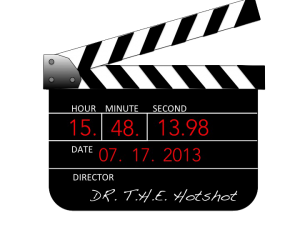 A hot trend in publishing these days is to make a media trailer to call attention to a book and its author. Whether you are an educator who’s written a textbook or a novelist, you may be considering a book trailer to reach a wider audience.
A hot trend in publishing these days is to make a media trailer to call attention to a book and its author. Whether you are an educator who’s written a textbook or a novelist, you may be considering a book trailer to reach a wider audience.
First off, what is a book trailer? A book trailer is a video that briefly summarizes what the book is about and what the reader will get out of it. Most people are familiar with movie trailers, which are used to advertise films. A movie trailer is typically composed of clips from the full-length film, which are strung together to give a preview of what the movie is all about. The whole point is to stimulate people’s interest and encourage them to go see the movie. A book trailer is very similar, except that it is advertising a written document instead of a cinematic product.
Why would an author need a book trailer? As a recently published author, I am aware of how difficult it is to get a book onto the radar of potential readers. A book trailer can be a very effective way to promote a book, along with all the traditional approaches of book marketing. A growing number of people are searching for information in the form of video. The public is already primed for visual advertisements such as movie trailers; so a book trailer is a form of advertisement that is readily understood by the public. That’s the good news. The bad news is that it can be expensive to hire someone to create a trailer for your book. Your publisher may not be willing to cover that cost, or you may be self-published and cannot afford it.
So what do you do?
Well, you can consider creating the book trailer yourself. It was a no-brainer for me to create a book trailer to advertise my ebook on how to make science videos. As I explain in my book, how we communicate has changed radically in the past few years, and having multimedia skills, such as videography, opens a whole new world of opportunity for anyone whose livelihood depends on getting a message out to end-users. In the past, one needed a trained film crew to make a video, but today we have inexpensive equipment that can capture high-definition images (even an iPhone can record 1080p video), powerful movie editing software that is cheap and easy to use (apps for mobile devices cost less than $10.00 US), and free video-sharing sites that make it easy to show your movie trailer to the world.
In this series of posts, I explain the process I went through to create a book trailer for The Scientist Videographer and then provide a tutorial to show an easy way to make one yourself with an iPad (or other mobile device).
Step One: Study Examples of Trailers. Watch a few book trailers and study what makes them effective and what aspects detract (ask yourself which parts make you want to buy the book and which ones turn you off). You want to peruse book trailers that advertise books in a variety of categories but especially those in your specific specialty. You want to know how the top sellers in your book category are structuring their trailers so that you can better decide whether to go along with the crowd or make a trailer that sets you apart from your competitors. By watching a variety of trailers for other types of books, you may get some good ideas for your particular book that will make it seem unique to potential readers. Oh, and you might also want to watch a few movie trailers as well. Hollywood has been successfully selling movies for decades; so you may pick up some good pointers from the experts.
Here are a few sites where you can watch some book trailers (and movie trailers). Note that I’m not saying these are good or bad examples, just examples to study:
http://www.booktrailersforreaders.com/
http://www.quirkbooks.com/stuff-categories/book-trailers
https://www.pinterest.com/librarygerbils/book-trailers/ (you have to follow the links to YouTube to watch the videos)
In the next post, I will explain step two: Hone your story.
